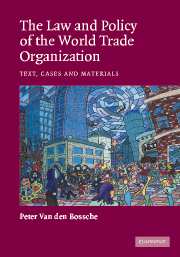Book contents
- Frontmatter
- Contents
- List of figures
- List of tables
- Preface and acknowledgments
- Table of cases
- Table of agreements and decisions
- 1 ECONOMIC GLOBALISATION AND THE LAW OF THE WTO
- 2 THE WORLD TRADE ORGANIZATION
- 3 WTO DISPUTE SETTLEMENT
- 4 PRINCIPLES OF NON-DISCRIMINATION
- 5 RULES ON MARKET ACCESS
- 6 RULES ON UNFAIR TRADE
- 7 TRADE LIBERALISATION VERSUS OTHER SOCIETAL VALUES AND INTERESTS
- 8 CHALLENGES FOR THE FUTURE
- Index
1 - ECONOMIC GLOBALISATION AND THE LAW OF THE WTO
- Frontmatter
- Contents
- List of figures
- List of tables
- Preface and acknowledgments
- Table of cases
- Table of agreements and decisions
- 1 ECONOMIC GLOBALISATION AND THE LAW OF THE WTO
- 2 THE WORLD TRADE ORGANIZATION
- 3 WTO DISPUTE SETTLEMENT
- 4 PRINCIPLES OF NON-DISCRIMINATION
- 5 RULES ON MARKET ACCESS
- 6 RULES ON UNFAIR TRADE
- 7 TRADE LIBERALISATION VERSUS OTHER SOCIETAL VALUES AND INTERESTS
- 8 CHALLENGES FOR THE FUTURE
- Index
Summary
INTRODUCTION
At the largest-ever gathering of Heads of State and Government, the Millennium Summit of the United Nations in September 2000, the UN General Assembly solemnly declared:
We will spare no effort to free our fellow men, women, and children from the abject and dehumanizing conditions of extreme poverty, to which more than a billion of them are currently subjected. We are committed to making the right to development a reality for everyone and to freeing the entire human race from want.
It was decided to halve the proportion of the world's people living in absolute poverty by the year 2015. While data of the World Bank show that the number of people in extreme poverty fell from 1.451 billion in 1981 to 1.101 billion in 2001, the enormity of the task ahead is obvious to all. The income gap between the richest 20 per cent of the world's population and the poorest 20 per cent does not cease to grow. During the 1990s, this gap increased from 60:1 to 86:1. In discussing the greatest challenges that the world faces, Jimmy Carter, the former US President, stated in his Nobel Lecture in December 2002:
Among all the possible choices, I decided that the most serious and universal problem is the growing chasm between the richest and poorest people on earth. The results of this disparity are root causes of most of the world's unresolved problems, including starvation, illiteracy, environmental degradation, violent conflict, and unnecessary illnesses that range from guinea worm to HIV/Aids.
- Type
- Chapter
- Information
- The Law and Policy of the World Trade OrganizationText, Cases and Materials, pp. 1 - 75Publisher: Cambridge University PressPrint publication year: 2005



